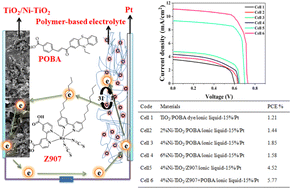Synthesis and characterization of a new phenothiazine-based sensitizer/co-sensitizer for efficient dye-sensitized solar cell performance using a gel polymer electrolyte and Ni–TiO2 as a photoanode†
Abstract
We synthesized POBA dye and studied its performance as a sensitizer and co-sensitizer. In addition, we present a simple method for producing Ni-doped TiO2 with various molar concentrations for use as a photoanode in a DSSC. Further, poly(vinylidene fluoride)/polyethylene glycol (PVDF-PEG) gel polymer electrolytes (GPEs) having different concentrations of 1-n-hexyl-3-methylimidazolium iodide were prepared and optimized for usage in DSSCs. We initially tested the performance of POBA dye on TiO2 and Ni-doped TiO2 photoanode materials. Among the POBA sensitized devices, 4% Ni–TiO2 showed a high efficiency of 1.85%. Then, we sensitized Z907 dye on the 4% Ni–TiO2 photoanode, followed by sensitizing it with POBA, which compensated the absorption defect of the Z907 dye as well as filling the gap between the standard dye molecules. This approach enhances and broadens the absorption spectrum of the dyes by molecular filling, compensates for the lack of absorption of Z907, and reduces the recombination of charges. The Z907-based DSSC showed 4.52% efficiency, and after co-sensitization, the DSSC showed an increase in efficiency (5.77%). These findings show that co-sensitizers can cover the naked spectrum in the ultraviolet-visible region, fill the empty space on Ni–TiO2, and reduce recombination reactions. The main motive of this research is to enhance the photo-ability of sensitizers and metal-free co-sensitizers in a Ni–TiO2 photoanode and blend gel polymer electrolyte-based DSSCs.



 Please wait while we load your content...
Please wait while we load your content...